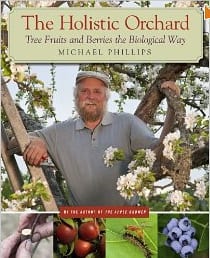The Holistic Orchard: Tree Fruits and Berries the Biological Way
Written by Michael Phillips
Published by Chelsea Green Publishing, 2011, 414 pages
Reviewed by Nick Novick
Interest seems to be on the rise in all things local and sustainable. The outstanding Vermont-based publisher, Chelsea Green, reflects—and, perhaps, feeds—this trend with many excellent titles on building, sustainable energy, food, and other subjects germane to an emerging future more socially egalitarian, less dependent on fossil fuels, and more locally rooted. Local food production and marketing tends to be at the forefront of this movement, so it makes perfect sense that The Holistic Orchard is among their recent offerings.
Expanding on the scope of his earlier book, The Apple Grower; a Guide for the Organic Orchardist Phillips’ new work not only includes more kinds of fruits, but, perhaps more significantly, deepens the conceptual framework within which fruit care resides. Right from the start, the title and subtitle hint at this by invoking holistic and biological as descriptors of an approach which seeks to consider as broad a context and as wide a range of factors as possible when setting out a care and maintenance regimen.
This is at once more complicated and more engaging than merely substituting “organic” pest and disease treatments for the more traditional “chemical” ones. Making the analogy to human health, the new approach focuses on building plant health as the main goal, and de-emphasizes the allopathic, direct-assault on insect and disease vectors which has so far characterized much of orchard care.
The factors to consider are many. These include understanding the ecological niche (forest edge) of fruit-bearing plants is key. Observing and understanding the conditions that exist there, and, as much as possible re-creating those conditions in the orchard should form a baseline starting point. Fungally dominated soil, maintained with ramial wood chips (chipped, smaller branches from hardwood trees) help to create the biologically appropriate root zone.
Supporting and enhancing innate plant health and defenses is another major emphasis in Phillips’ scheme. In addition to the familiar work of maintaining soil fertility and foliar supplements, the holistic program here puts a large emphasis on pure neem oil and fish hydrolysate in helping to boost plant defenses. The fatty acids these material contain, the theory goes, can help support beneficial leaf- and bark-dwelling microbes (either native or enhanced via application of effective microbes and/or compost tea), as well as soil biology, especially the fungal component.
The range of holistic tools continues with herbal extracts (notably equisetum and stinging nettle), “random” application of ramial wood chips in selected spots under the tree, and—borrowing from permaculture protocol—growing lower stature, companion plants under and among the fruit trees.
Apart from this “new” holistic paradigm, the book contains a wealth of basic information and detail about site selection, pruning, protection from critters and birds, varietal characteristics, etc. that one would find in any good cultural guide. Extensive end notes, a resource list, an “orchard year” summary of tasks, and index add to the density of information and the usefulness of the book.
The sheer amount of information and detail could prove overwhelming to those new to growing fruit, but those folks could still pick and choose their way to garner what they needed to get started while leaving some of the nuance to future growing seasons. Those for whom apples are the main interest would benefit from spending time with the earlier book, The Apple Grower.
As expansive as the thinking is throughout the book, there are a few instances where suggested practices rest on a kind of less-than-fully-supported optimism. One instance of this is the promotion of compost tea and “effective microbes” as a means to deter potential foliar diseases. It may well be that extracted and brewed microbes, when applied to leaf, twig, and bark surfaces colonize leaf surfaces and antagonize or out compete disease vectors, but the science on this is thin to—in some instances—nonexistent. Despite the emphasis on this tool as part of the holistic program, the book provides no independent citations on the efficacy of applied microbes.
Aside from wishing that the chapter numbers were better keyed to the notes section (it can be a bit cumbersome to find a particular note if one jumps into the middle of a chapter), there is little else to criticize here.
Simply put, if you grow fruit, or are planning to in the future, you need this book. For beginners to seasoned growers, there’s a wealth of detailed, integrated information here that will serve as a valuable resource through many seasons of growing and harvesting.
About the Author
Nick Novick operates Small Planet Landscaping which specializes in native plant installations and fruit-tree care. He is also a former board member of ELA and currently represents ELA on the Massachusetts Invasive Plant Advisory Group.


